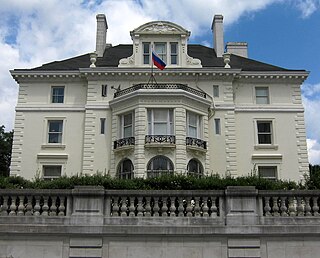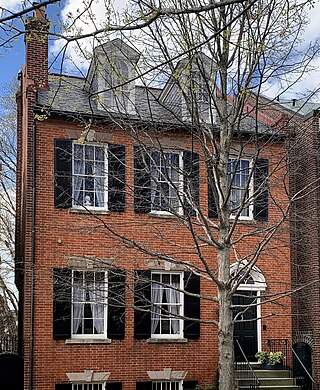
The Victorian Village District is an area of Memphis, Tennessee.

Arlington House is the historic Custis family mansion built by George Washington Parke Custis from 1803–1818 as a memorial to George Washington. Currently maintained by the National Park Service, it is located in the U.S. Army's Arlington National Cemetery in Arlington County, Virginia. Arlington House is a Greek Revival style mansion designed by the English architect George Hadfield. The Custis grave sites, garden and slave quarters are also preserved on the former Arlington Estate.

James Madison's Montpelier, located in Orange County, Virginia, was the plantation house of the Madison family, including Founding Father and fourth president of the United States James Madison and his wife, Dolley. The 2,650-acre (1,070 ha) property is open seven days a week.

Tudor Place is a Federal-style mansion in Washington, D.C. that was originally the home of Thomas Peter and his wife, Martha Parke Custis Peter, a granddaughter of Martha Washington. The property, comprising one city block on the crest of Georgetown Heights, had an excellent view of the Potomac River.

Oatlands Historic House and Gardens is an estate located in Leesburg, Virginia, United States. Oatlands is operated by the National Trust for Historic Preservation and is listed on the National Register of Historic Places as a National Historic Landmark. The Oatlands property is composed of the main mansion and 415 acres of farmland and gardens. The house is judged one of the finest Federal period country estate houses in the nation.

Ward Hall is a Greek Revival antebellum plantation mansion located in Georgetown, Kentucky. The main house covers 12,000 square feet (1,100 m2), with 27-foot (8.2 m) high Corinthian fluted columns.

The Lee–Fendall House is a historic house museum and garden located in Old Town Alexandria, Virginia, United States, at 614 Oronoco Street. Since its construction in 1785, the house has served as home to thirty-seven members of the Lee family (1785–1903), hundreds of convalescing Union soldiers (1863–1865), the prominent Downham family (1903–1937), the family of powerful labor leader John L. Lewis (1937–1969), and enslaved or free servants of those families.

The Belair Mansion, located in the historic Collington area and in Bowie, Maryland, United States, built c. 1745, is the Georgian style plantation house of Provincial Governor of Maryland, Samuel Ogle. Later home to another Maryland governor, the mansion is listed on the National Register of Historic Places.

Newton D. Baker House, also known as Jacqueline Kennedy House, is a historic house at 3017 N Street NW in Washington, D.C. Built in 1794, it was home of Newton D. Baker, who was Secretary of War, during 1916–1920, while "he presided over America's mass mobilization of men and material in World War I. After the assassination of president John F. Kennedy in 1963, Jacqueline Kennedy purchased the house and lived here for about a year.

Rose Hill Manor, now known as Rose Hill Manor Park & Children's Museum, is a historic home located at Frederick, Frederick County, Maryland. It is a 2+1⁄2-story brick house. A notable feature is the large two-story pedimented portico supported by fluted Doric columns on the first floor and Ionic columns on the balustraded second floor. It was the retirement home of Thomas Johnson (1732–1819), the first elected governor of the State of Maryland and Associate Justice of the United States Supreme Court. It was built in the mid-1790s by his daughter and son-in-law.

The Dodge Mansion, also known as Turner-Dodge House, is a historic house in Lansing, Michigan that was built in 1855. It was listed on the National Register of Historic Places (NRHP) in 1972 as Dodge Mansion.

Tregaron Estate, formerly known as The Causeway, is a country house and estate located in the Cleveland Park neighborhood of Northwest, Washington, D.C. The estate, built in 1912, was designed by architect Charles Adams Platt and landscape architect Ellen Biddle Shipman. The original owners, Alice and James Parmelee, lived at the estate from the time of its construction until 1940. From 1942 to 1958, it was occupied by Joseph E. Davies, who had served as United States ambassador to several countries, and his second wife, Post Cereal Company heiress Marjorie Merriweather Post. Today the estate is occupied by a campus of the Washington International School and the Tregaron Conservancy.

Brooks Mansion is a Greek Revival plantation house and Category II Landmark owned by the District of Columbia government. It is located at 901 Newton Street, Northeast, Washington, D.C., in the Brookland neighborhood, next to the Brookland–CUA.

Prospect House is a historic building, located at 3508 Prospect Street, Northwest, Washington, D.C., in the Georgetown neighborhood.

The Lothrop Mansion, also known as the Alvin Mason Lothrop House, is an historic home, located at 2001 Connecticut Avenue, Northwest, Washington, D.C., in the Kalorama Triangle neighborhood.

Isaac Owens House, also known as the Gannt-Williams House or John Walker House, is a historic building located at 2806 N Street NW Washington, D.C., in the Georgetown neighborhood.

The White-Meyer House is a historic mansion in Washington, D.C., located in the Meridian Hill neighborhood of Northwest D.C. It was designed by American architect John Russell Pope and built by order of American diplomat Henry White. For several years, the house was rented to Eugene Meyer, who then bought it in 1934. It was bought by non-profit organization Meridian International Center in 1987.

The General John Frelinghuysen House is a historic building located in Raritan, New Jersey. The older west wing was originally a tavern, built sometime before 1756 by Cornelius Bogert, when it also served as the town's meeting hall. It was bought in 1801 by John Frelinghuysen and then came to be known as the Frelinghuysen Homestead. It is an excellent example of early 19th century Federal architecture in New Jersey. In 1975, it was donated by Peter Frelinghuysen, Jr. to the borough and now serves as the Raritan Public Library.

The McKennon-Shea House is a historic house at 206 Waterman Street in Dumas, Arkansas. The 1+1⁄2-story wood-frame house was built c. 1910, and bought in 1913 by Claude McKennon, a local entrepreneur who established a farm supply business in Dumas at about the same time, and built a real estate empire of farmland operated by tenant farmers. Mckennon's daughter Sarah married Thomas Shea, and their son inherited the property. The house is a vernacular rendering of Folk Victorian and Colonial Revival styling, with gingerbread decoration and four Tuscan columns supporting a central projecting gable.

Ferdinand "Mot" Lammot Belin was an American diplomat who served as Chief of Protocol of the United States and as the U.S. Ambassador to Poland in the early 1930s.





















